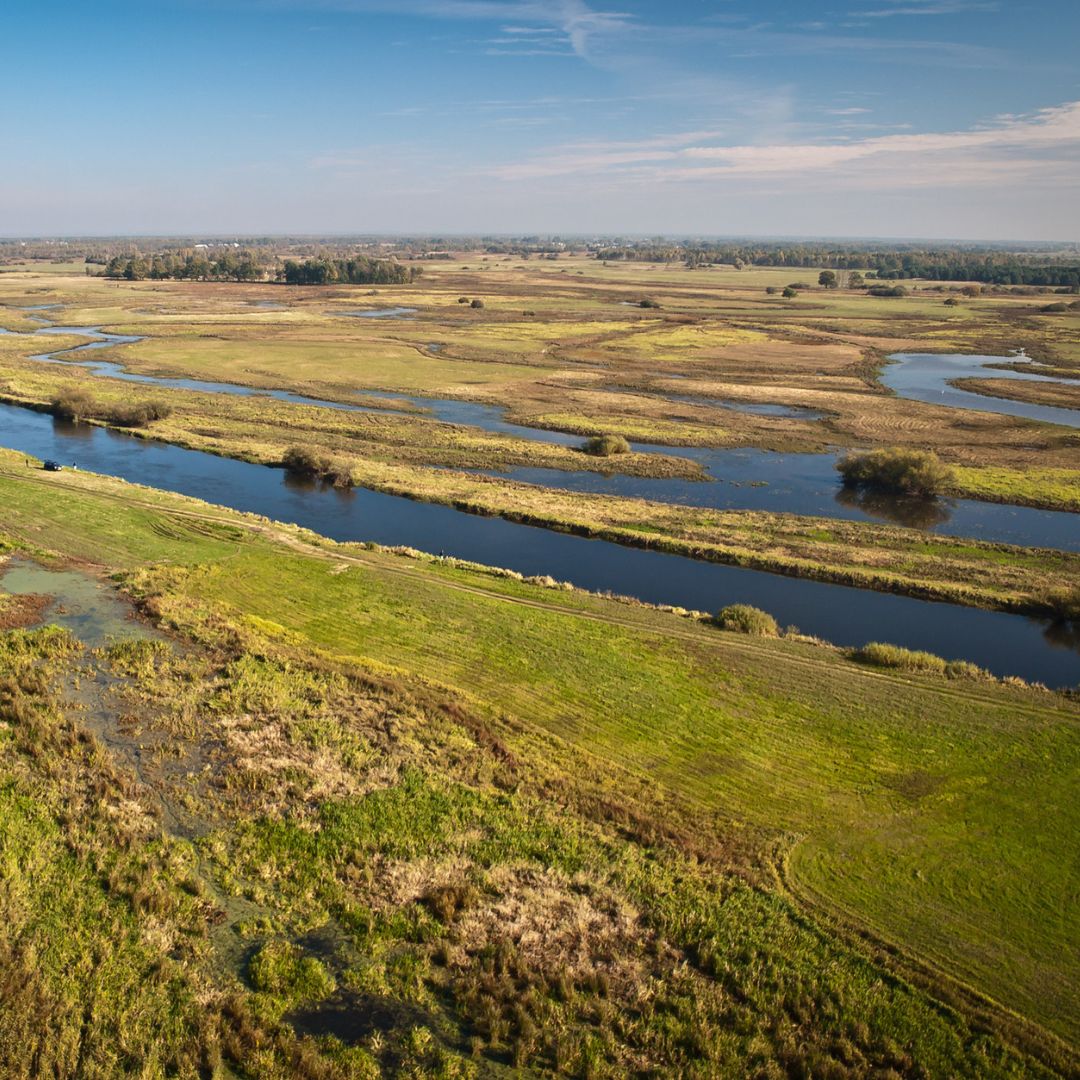Biebrza two years after the fire – causes and consequences of the fire for the Biebrza National Park ecosystem
Properly functioning bogs are wetlands. Therefore, the risk of fire on them occurs due to drying, which most often results from drainage work and periods of drought, leading to a drop in the water level of the peatland. The persistently low water level increases the risk of a pit fire, involving not only the peatland vegetation, but also the peat deposit itself.
A fire in the Grzêdy bog in April 2020 covered approx. 10% of the area of the Biebrza National Park (5,500 hectares). Fortunately, it was surface in nature, so there was no permanent damage to the peat deposit. Vegetation and the surface layer of peat were burned. Along with them, the microfauna – invertebrates and small vertebrates, including the young of ground nesting birds – has been destroyed. Burning of vegetation has led to the loss of breeding sites for many bird species (such as cranes, lapwings, choughs and aquatic warblers), as well as toking sites for dubelt and black grouse.
In June 2020, the water level in the peatland rose thanks to heavy rainfall, which promoted the natural regeneration of the fire. Along with the regrowth of vegetation, birds appeared – at first common species (e.g. lark, reed warbler, cuckoo), with time also species typical of peatlands (e.g. aquatic warbler, common snipe, oddball). Eagles and black grouse have also returned. Pyrophilous species of bryophytes, fungi and insects, which are rare in Poland, have also appeared in the burned area. It seems that the regeneration of the Grzęda bog is on track, although it will probably take a few more years. The regeneration process is being monitored by the Forest Research Institute, which has included the wildfire in a 5-year research program.
Source: Biebrza National Park website, https://www.biebrza.org.pl/lang,pl
Dr. Monika Mętrak / Faculty of Biology, UW
What are the consequences of peatland fires in the Biebrza National Park? Are fires always harmful to the environment? Dr. Marcin Sulwinski of the UW Department of Biology answers these questions.
Are fires always harmful to the environment?
We associate fires unequivocally negatively – they cause property damage and are a threat to health and life. Are fires always harmful to the environment? Well, perhaps surprisingly – not always. It all depends on what, where and how you burn. There are ecosystems where fires are a natural and frequent occurrence. One example is the savannah, which can burn every year.
Fires are a natural part of nature especially in regions with dry climates, where low water availability makes it difficult to decompose dead organic matter. The regular occurrence of fires has caused plants to adapt to their occurrence, just as meadow plants have adapted to mowing. Fires cause high mortality of trees and shrubs, which gives herbaceous plants a chance to thrive that would otherwise be shaded and displaced. Also, the removal of accumulated organic matter gives better light conditions to low and young plants. There are even plant species that will not germinate if their seeds are not heated during a fire. Some plants secrete essential oils so flammable that they ignite themselves in hot weather. The result is the burning of such a plant, but also of other plants growing in the vicinity that compete with the new generation of plants. In such ecosystems, fires are essential for maintaining high species diversity.
However, the condition is that fires occur at a natural rhythm and intensity. In the past, it was popular to prevent fires at all costs, which was pursued, for example, in reservations. Where fires occurred naturally, it produced the opposite of the expected results. The lack of periodic removal of accumulated organic matter caused the disappearance of light-loving plant species. Instead of low-intensity fires occurring every few years, there were fires of unprecedented intensity, impossible to extinguish, destroying everything to the bare ground. Nowadays, especially in North America, there is already a high awareness of the fact that in some ecosystems, fire is an essential factor in maintaining the high conservation value of protected areas. Deliberate arson is even used as a conservation tool! Deliberate arson, however, takes place under controlled conditions, in favorable weather, and only when the amount of accumulated fuel does not threaten the outbreak of a fire of excessive intensity.
The situation is different in ecosystems where fires naturally occur rarely or not at all. Plants there have not developed mechanisms to survive fire. Fires then have no positive effect and can cause the emergence of invasive species and the disappearance of species that are particularly sensitive to fire, incidentally causing heavy property damage. The vast majority of Poland’s ecosystems are not adapted to fire. The exception is heathlands, which can form naturally after pine forest fires that remove trees. The absence of periodic fires will result in the development of trees, the shading of the ground and the disappearance of the heath. Until the next fire, after which the cycle may repeat.
Types of peatland fires and their causes
Peatlands are wetland ecosystems where the substrate is always wet. The high moisture content of the substrate creates anaerobic conditions that make it impossible for microorganisms to fully decompose plant remains. Under such conditions, peat is formed. It can store water like a sponge. So can a fire occur where the ground is saturated with water? Of course, a surface fire can occur, during which accumulated above-ground organic matter, such as dry grasses and dead branches, burns. Flames familiar to most fires then occur. Fire travels quickly and causes relatively little damage to plants. Such fires can have natural causes (lightning), can travel from neighboring burning areas, or can be man-made.
Another type of fire can also occur in peatlands – one in which peat ignites. Peat in natural peat bogs is saturated with water and there is no way for it to catch fire. The situation is different in drained peatlands. A natural bog, while it may be extremely valuable in terms of nature, from a farmer’s point of view can be at best a source of poor-quality hay, worse, difficult to harvest. Drainage makes it possible to turn the bog into meadow or pasture, drive a tractor into it, and harvest much larger quantities of hay. Unfortunately, the drainage of the peatland entails a number of unfavorable consequences: the disappearance of valuable plant species, significant CO2 emissions, the progressive sterilization of the peat – in the longer term so strong that any agricultural management becomes unprofitable. Dried peat can ignite and glows in a similar way to charcoal – flameless combustion occurs. This type of fire is called a subsurface fire. It usually starts as a surface fire, from which sufficiently dried peat then ignites.
Effects of peatland fires in Biebrza National Park
Naturally valuable peatlands are characterized by very low availability of nitrogen and/or phosphorus. This allows them to host rare plant species that would otherwise be displaced by stronger, common species. Therefore, it is necessary to do everything possible to avoid increasing the fertility of the soil. The effects of peatland fires can vary greatly depending on their nature.
A surface fire moves quickly, lasts a short time and, as a result, small amounts of heat enter the ground. Soil organisms living a few inches off the ground may not even notice that something has burned on the surface of the peat. Relatively small amounts of ash are also produced, enriching the substrate with phosphorus. Therefore, such fires should not significantly affect the peatland’s vegetation. Peat ignition carries much more serious consequences. Peat burns slowly, moves at a rate of a few centimeters per hour and can last for months.
As a result of heating the peat near the fire, plant roots and seeds in the soil die, and animals that live in the peat also perish. A layer of peat tens of centimeters thick can burn off, resulting in a huge amount of ash. There is then a significant increase in the availability of elements, the deficiency of which previously prevented the development of undesirable species. In the Biele Suchowolskie peatland, which was burned in this way, there was a dramatic change in vegetation cover. Within a few years, the areas of the bog affected by the fire were dominated by willows, and all rare plant species disappeared. The valuable open ecosystem has turned into a common, species-poor scrub without much wildlife value, and birds that prefer areas with a low proportion of trees and shrubs have also fled.
The fires that broke out over the Biebrza River in April 2020 covered several thousand hectares of peatlands. Their emergence was associated with severe drought. Fortunately, the peat did not catch fire (or possibly it only happened on a small scale), and only the dried above-ground biomass of the plants was burned. The fires occurred at the very beginning of the growing season, which also made them less severe for the plants. While it may still be too early to know the long-term effects of these fires, it is hoped that they will not clearly adversely affect the presence of rare plant species. However, it should be remembered that any fire definitely negatively affects animals, especially those that are unable to escape the fire. Hence, fire outbreaks in ecosystems unsuited to them should be prevented.
Dr. Marcin Sulwinski / Faculty of Biology, UW
The post is part of a series on natural heritage titled „How to live? – Naturally!” And all this to draw the attention of our readers to the need to protect the natural heritage of our Earth.
#naturalheritage #worldheritage #ExpertsUW #unesco #natural




